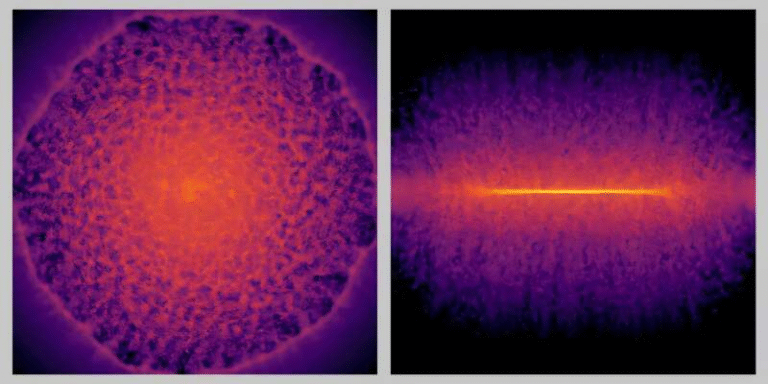Alien Civilizations Might Be Detectable Only for a Cosmic Blink of an Eye

Could it be that alien civilizations exist but are practically invisible to us?
A new scientific paper suggests that might be the case — and the reason lies not in the vastness of space, but in the accelerating speed of technology itself.
The Main Idea: The Shrinking Window of Detectability
The study, titled “Blink and You’ll Miss It — How Technological Acceleration Shrinks SETI’s Narrow Detection Window”, was authored by Michael A. Garrett, Director of the Jodrell Bank Centre for Astrophysics. It was recently uploaded to the arXiv preprint server and accepted for publication in Acta Astronautica. Garrett revisits an old thought from the 1970s by Carl Sagan, who once proposed that civilizations might only be detectable for a limited time before advancing beyond our ability to recognize their signals.
The heart of the study is a simple but profound question: How long is a civilization visible to others through its technological signatures? Garrett’s model suggests that as technology evolves faster and faster, that detectable window — the period when an extraterrestrial civilization (ETC) emits signals we can recognize — could last only a few decades.
That’s a blink of an eye in cosmic terms.
The Communication Horizon
Carl Sagan’s original idea of the “communication horizon” is central here. In the 1970s, Sagan argued that as civilizations advance, their methods of communication evolve beyond our ability to detect them. Humans, for example, began with radio waves that could be detected across light-years. But what happens when a civilization moves to neutrino communication or quantum data transfer? Those technologies would be invisible to us using current instruments.
Sagan estimated it might take around a thousand years for a civilization to progress beyond detectability. Garrett re-examines that assumption in light of today’s accelerating technological curve — especially considering the rise of artificial intelligence (AI) and computing. His conclusion: we may have far less time to catch a signal than Sagan imagined.
The Role of Artificial Intelligence
Garrett’s paper highlights the impact of AI and technological acceleration on this shrinking window. Human progress, once measured in centuries, now moves at an exponential rate. If a civilization develops artificial superintelligence (ASI), its technology could advance beyond biological comprehension within a few decades. That means any technosignature — a detectable sign of technology such as radio emissions — would appear and vanish long before another civilization like ours could detect it.
In other words, we may simply be out of sync with the rest of the galaxy.
This concept offers a new angle on the Fermi Paradox, the enduring question of why we haven’t detected alien civilizations despite the enormous number of potentially habitable worlds. If technological civilizations evolve so rapidly, their detectable phases might never overlap — even if they are numerous.
The “Narrow Detection Window” Model
Garrett proposes a model describing how the “detection window” depends on a civilization’s rate of technological acceleration. A slow-moving civilization might remain visible for centuries, giving SETI (Search for Extraterrestrial Intelligence) plenty of time to catch a signal. But a fast-moving one, propelled by exponential technological growth, could be detectable for less than 100 years.
The math shows that as technology speeds up, this window collapses dramatically. Civilizations may exist in abundance, but their technosignatures could be fleeting — appearing only during a short stage before they transition to undetectable modes of communication or merge entirely with their technology.
This suggests that our odds of detection are incredibly small, not because aliens don’t exist, but because we’re looking during the wrong sliver of time.
Beyond Radio Beacons: Rethinking SETI
Traditional SETI searches focus on narrowband radio signals, under the assumption that other civilizations might intentionally broadcast messages or leak radio noise, as humans did during the mid-20th century. But Garrett’s findings argue for a much broader strategy.
He suggests expanding SETI’s search field to include non-traditional technosignatures such as:
- Infrared “waste heat” from mega-engineering projects like Dyson spheres.
- Anomalous energy distributions across galaxies.
- Optical or broadband electromagnetic leakage from advanced systems.
- Even multi-messenger signals involving gravitational waves or neutrinos.
To find such subtle traces, SETI researchers may increasingly rely on AI-based anomaly detection systems, which can scan massive datasets from telescopes and satellites for unexpected patterns. After all, if we don’t know what alien technology looks like, we’ll need machines that can find what humans might overlook.
Implications for Humanity
This theory doesn’t just explain why we haven’t found aliens — it also says something about our own future. Humanity may already be approaching its own short detection window.
For about a century, Earth has been leaking radio signals into space. But as we transition to fiber optics, encrypted digital networks, and satellite relays, our planet’s electromagnetic footprint is actually shrinking. In a few more decades, Earth may go silent to an outside observer.
That means that if an alien civilization 100 light-years away were listening in right now, they’d detect our 20th-century broadcasts — but by the time their signal reaches us and we respond, we might no longer be detectable at all.
In that sense, we might be living through the very brief cosmic moment when humanity itself is visible to the rest of the universe.
The Broader Context: The Great Silence
The Fermi Paradox — “Where is everybody?” — has long puzzled scientists. We’ve discovered over 6,000 exoplanets so far, and statistics strongly suggest that billions of potentially habitable worlds exist in our galaxy alone. And yet, despite decades of searching, we’ve found no signs of alien civilizations.
Common explanations include:
- Life is rare and fragile.
- Civilizations self-destruct before they can spread.
- The universe is a “cosmic zoo,” where advanced species observe us but avoid contact.
- Or that we’re simply the first to reach this level of technology.
Garrett’s theory adds another layer: maybe civilizations are plentiful, but their detectable lifetimes are too short to ever overlap. It’s not that no one’s out there — it’s that we’re all blinking in and out of detectability at different times.
Why This Study Matters
This research challenges the foundation of SETI strategy and reminds us that our expectations may be too narrow. If we assume that alien civilizations resemble us — biologically based, radio-using, and long-lived — we’re likely to miss them entirely.
By recognizing that technology itself evolves exponentially, and that civilizations might transition into non-biological, post-detectable forms, SETI can rethink how it searches the skies. Instead of waiting for a radio message, we might look for patterns, heat signatures, or energy anomalies that don’t fit natural astrophysical processes.
It also forces a humbling realization: our window to be seen by others may be closing, just as theirs did long ago.
Final Thoughts
Garrett’s paper doesn’t claim to solve the mystery of extraterrestrial life, but it offers a compelling new lens. Maybe the universe is full of intelligent beings who, like us, race through technological evolution so quickly that their detectable phases barely register on cosmic timescales.
In that case, the Great Silence isn’t evidence of absence — it’s just a timing problem. We might simply be listening during a quiet part of the cosmic symphony.
If that’s true, then perhaps the real question isn’t “Where is everybody?”, but rather “When are they?”
Research Paper: Blink and You’ll Miss It — How Technological Acceleration Shrinks SETI’s Narrow Detection Window (Michael A. Garrett, 2025, arXiv)





